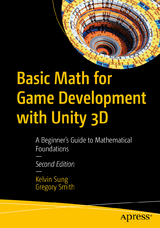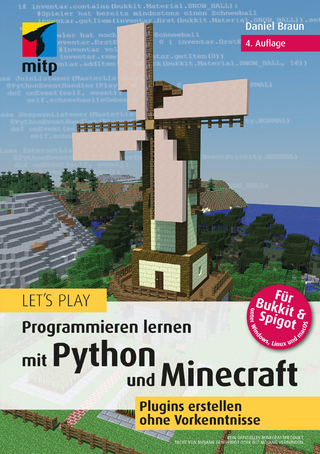
Basic Math for Game Development with Unity 3D
Apress (Verlag)
978-1-4842-5442-4 (ISBN)
- Titel erscheint in neuer Auflage
- Artikel merken
Use Unity-based examples to understand fundamental mathematical concepts and see how they are applied when building modern video game functionality. You will gain the theoretical foundation you need, and you will know how to examine and modify an implementation.
This book covers points in a 3D Cartesian coordinate system, and then discusses vectors and the details of dot and cross products. Basic mathematical foundations are illustrated through Unity-based example implementations. Also provided are examples showing how the concepts are applied when implementing video game functionality, such as collision support, motion simulations, autonomous behaviors, shadow approximations, and reflection off arbitrary walls.
Throughout this book, you learn and examine the concepts and their applications in a game engine.
What You Will Learn
Understand the basic concepts of points and vectors and their applications in game development
Apply mathematical concepts to modern video game functionality, such as spherical and box colliders
Implement autonomous behaviors, including following way points, facing a target, chasing an object, etc.
Who This Book is For
Beginners, and those interested in the implementation of interactive games, who need a basic mathematical background or a refresher with modern examples
Kelvin Sung is a professor with the Computing and Software Systems division at the University of Washington Bothell (UWB). He received his PhD in Computer Science from the University of Illinois at Urbana-Champaign. Kelvin’s background is in computer graphics, hardware, and machine architecture. He came to UWB from Alias|Wavefront (now part of Autodesk), where he played a key role in designing and implementing the Maya Renderer, an Academy Award-winning image generation system. At UWB, funded by Microsoft Research and the National Science Foundation, Kelvin’s work focuses on the intersection of video game mechanics, solutions to real-world problems, and mobile technologies. He has co-authored four books: one in computer graphics and the others in 2D game engines, including publishing with APress. Gregory Smith is a graduate student in the Computer Science and Software Engineering degree program at the University of Washington Bothell. He received his undergraduate degree in Computer Science from Northwest Nazarene University in 2018. Greg is interested in machine learning, AI, and video game design. As his senior capstone project, he worked on the FireMAP project at Northwest Nazarene University where he applied machine learning algorithms to analyze drone images in order to map burned areas left by wildfires to achieve faster and safer recovery efforts. He was also a software engineer tester at a local company while pursuing his undergraduate degree. Currently, Greg is working on a project that focuses on allowing users of virtual and augmented realities to communicate and interact with each other within these mixed reality environments.
Chapter 1: Introduction and Learning Environment
Chapter Goal: Sets the context, describes prerequisite knowledge, discusses learning philosophy, guides to install, and presents a very brief tutorial on working with Unity.
Sub-topics
1. Philosophy, Background, and What You Will Learn
2. The Platform of Learning: Unity
3. C# Scripting: Modifying Behaviors in Unity
Chapter 2: Points and Bounds
Chapter Goal: Begins coverage with something very simple. Presents points, distances, and applications of these simple concepts
Sub-topics
1. Points and Distances
2. Colliders: Spheres
3. Ranges and Intervals
4. Colliders: Axis Aligned Boxes
5. Inside/Outside Tests
6. Limitations of the Colliders
Chapter 3: Vectors
Chapter Goal: Introduces vectors and applications of vectors.
Sub-topic
1. Vectors: Size and Direction
2. Velocity
3. Lines and Rays
4. Applications: Following Way Points, Patrolling, Proximity-Based Behavior
Chapter 4: Vector Dot Products
Chapter Goal: Introduces dot products and its applications.
Sub-topics
1. Dot Product Definition
2. Interpretation of Results: Direction and Projection
3. Point to Line Distance: Application in Proximity Tests
4. Line to Sphere Intersection: Application in Ray Casting
Chapter 5: Planes
Chapter Goal: Acquaints readers to plane equation and applications involving planes.
Sub-topics
1. Interpreting the Plane Equation
2. Plane Normal Vectors
3. Point to Plane Distance
4. Line to Plane Intersection: Application in Dropping Shadows
5. Reflecting a Vector: Application in Bouncing an Object
6. Applications: Projections, Direction Aware Behaviors
Chapter 6: Vector Cross Products
Chapter Goal: Defines cross products and its applications
Sub-topics
1. Cross Product Definition
2. Interpretation of Results: Area and Direction
3. Spanning of a Plane
4. Identifying Directions
5. Following and Chasing Behaviors
Chapter 7: Conclusion
Chapter Goal: Summarizes the book and learnings
Sub-topics
1. Summary and Context of Knowledge
2. What’s Next and Why
3. Further Readings and References
| Erscheinungsdatum | 23.12.2019 |
|---|---|
| Zusatzinfo | 97 Illustrations, black and white; XVIII, 403 p. 97 illus. |
| Verlagsort | Berkley |
| Sprache | englisch |
| Maße | 155 x 235 mm |
| Gewicht | 646 g |
| Themenwelt | Informatik ► Software Entwicklung ► Spieleprogrammierung |
| Mathematik / Informatik ► Informatik ► Theorie / Studium | |
| Mathematik / Informatik ► Mathematik ► Angewandte Mathematik | |
| Mathematik / Informatik ► Mathematik ► Computerprogramme / Computeralgebra | |
| Schlagworte | Basic mathematics • C# • Dot/Cross products • Game Development • Points • UNITY • Vectors |
| ISBN-10 | 1-4842-5442-2 / 1484254422 |
| ISBN-13 | 978-1-4842-5442-4 / 9781484254424 |
| Zustand | Neuware |
| Informationen gemäß Produktsicherheitsverordnung (GPSR) | |
| Haben Sie eine Frage zum Produkt? |
aus dem Bereich



